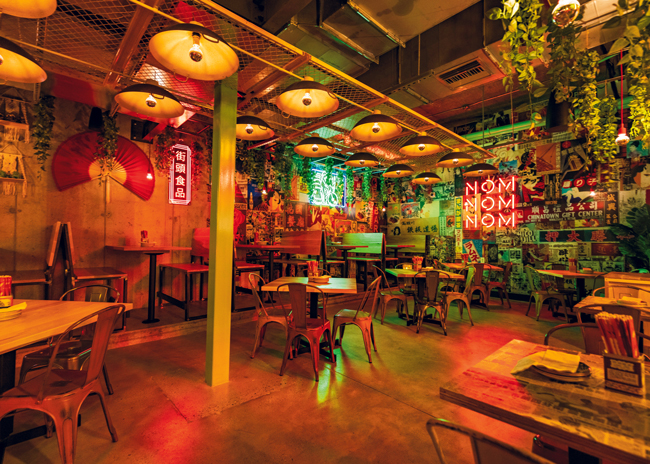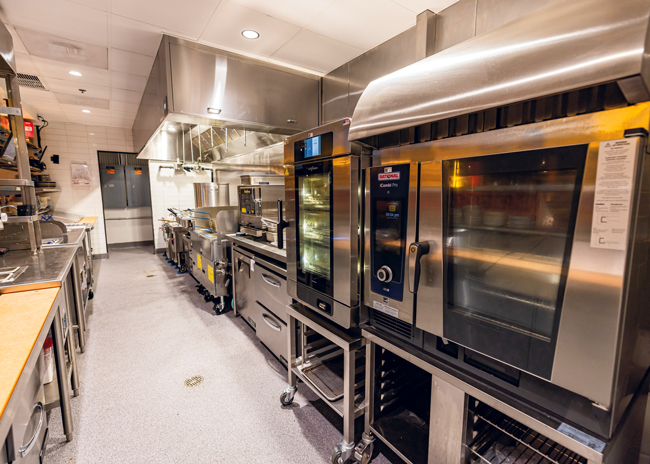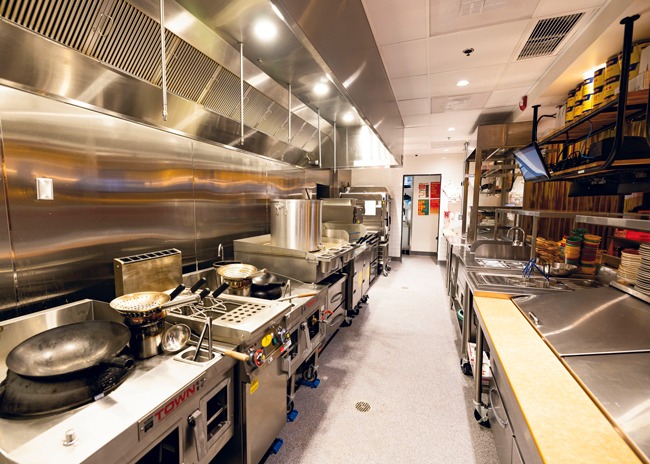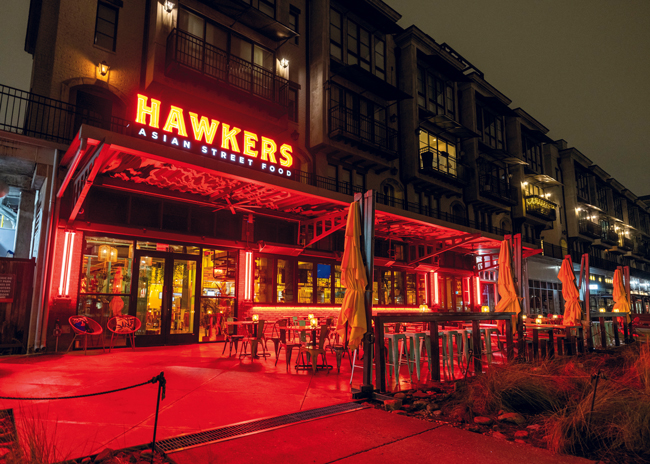This street-food concept seeks to recreate the hawker centers of Asia.
In less than a year, Hawkers Asian Street Food has gone from Chapter 11 to growth mode. In September 2024, the Orlando, Fla.-based chain filed for bankruptcy protection. The move, according to the company, wasn’t driven by the actual performance of its 15 restaurants but by a dispute with its key lender. Four months later, Hawkers reached a deal to restructure its debt with the lender, allowing the company to withdraw the bankruptcy filing.
Hawkers built on this momentum this past June, when it announced an investment from Savory Fund, a private equity firm focused on emerging restaurant brands.
That’s a lot of drama, even for a concept that aims to “spark adventure” with every guest visit.
 Images courtesy of Hawkers
Images courtesy of Hawkers
From FOMO to Chain
Hawkers’ story starts with four friends and future Hawkers co-founders: Kaleb Harrell, Kin Ho, Allen Lo and Wayne Yung.
“The other three guys’ families are from Asia. I grew up with them and traveled with them. When we would travel, it would be to Asia. Any time we traveled, the focus was on the food of where we were traveling,” says Harrell.
Street food (no surprise) sold by vendors, dubbed “hawkers,” was the main focus. These hawkers can be found on busy street corners throughout East and Southeast Asia but also in hawker centers — complexes of street-food stalls akin to food courts where all sorts of sellers serve generations-old recipes.
You can guess the rest. Harrell and friends loved the food and experience of hawker centers and spitballed about opening a restaurant that recreated that vibe.
“We talked about it, kind of joked about it. ‘Hey, it’d be cool to start a restaurant one day,’” Harrell recalls. “Then one day, my partner Allen approached me and said, ‘Hey man, I found a space. We can get into it really cheap.’ Of course my answer was ‘Absolutely not — that’s the dumbest idea I’ve ever heard.’ Really, why I’m here is FOMO because he managed to get the other two guys on board.”
In 2011, the partners opened the first location of Hawkers Asian Street Food. Since that time, the chain has expanded as far north as Maryland and as far west as Texas, moving into seven states total.
Intentionally Unrefined
Hawker centers can be found throughout East and Southeast Asia, and Hawkers’ menu reflects this. The chain’s offerings include noodles from Thailand, bulgogi from Korea and baos from China. Guests can also order Malaysian flatbread accompanied by the chain’s signature curry dipping sauce, wonton soup from Hong Kong or fried chicken from Japan.
With so many options for guests to sample, Hawkers serves its food small-plate-style. This allows customers to sample different dishes and “have an adventure” by trying something new, says Harrell. “Everything comes out as it’s ready,” he says. “It’s all sharing-encouraged when it hits the table. So it’s not like you order a pad thai and I order curry duck noodles. We’re ordering them together as a table. We’re sharing that food with small plates and enjoying the food and talking about the food.”
Recreating the experience of a hawker center means Hawkers also has plenty of inspiration for its design.
In terms of materials, the restaurant is intentionally unrefined. The floors, for instance, are sealed concrete. Corrugated metal, either as wainscoting or ceiling elements, can be found in several restaurants. Seating primarily consists of metal chairs like those found throughout Asia. “They’re not the most comfortable chairs in the world, but they work, and that’s part of that experience of being on the streets of Asia,” Harrell says.
Other design touches are also inspired by that part of the world. Neon lights, for example, are prominent in major cities throughout East Asia, Harrell says, and Hawkers has neon signs in its restaurants. Some signs feature text written with Asian characters. Others have Instagram-friendly phrases, like “Send Noodles” and “Nom Nom Nom.” Many walls are completely covered with overlapping posters and signs like those seen on the streets of Asia.
 The bar at Hawkers is the focal point of the restaurant’s layout, bringing energy and activity to the whole dining area.
The bar at Hawkers is the focal point of the restaurant’s layout, bringing energy and activity to the whole dining area.
The company also puts lots of thought and work into its tables, which it fabricates in-house. These are made of solid wood — usually ash — and some are covered with a newsprint design. This is another touch inspired by actual hawker centers.
“If you went to a more rural hawker center, particularly 25 years ago when we were growing up, and ordered a noodle dish to go, they would actually cook the noodles in the wok, ladle them into a piece of newspaper, fold it up, put a rubber band around it and hand it to you,” says Harrell. “Obviously, we didn’t want to serve our food in newspaper, so we took that inspiration and did some newspaper tabletops.”
And of course, the layout of the space is also a key part of the experience. Hawker centers can be either an indoor or outdoor space, so Hawkers locations offer patio dining. The chain, says Harrell, particularly likes garage doors and accordion-style doors that fold open, creating an indoor/outdoor experience for guests.
Inside, the bar sits front and center — both literally and figuratively — making it one of the first things guests encounter. The bar also serves as the source of much of the restaurant’s energy. “You see the bartenders bustling back and forth, folks coming and going, sitting at high-tops. It feels a little bit more high-energy,” Harrell says. “We want that energy to be at the center of the restaurant, just like when you’re on the streets of Asia. It’s a bustling place, borderline chaotic, and we want to emulate a version of that in our restaurants.”
Another key source of energy: Hawkers’ open kitchen. Just like hawker centers, the chain cooks its food in the open. Guests at Hawkers can see the flames from the woks, hear the clanging and the sizzle, and smell dishes as they are being cooked. “We really focus on a five senses experience,” Harrell says. “We want people to not only taste the food but to see it, hear it, touch it. Activating all those senses creates a true 360 experience.”
 Hawkers recently swapped out a traditional Chinese roasting oven for combis. These units produce more consistent product and are safer to use, the chain says.
Hawkers recently swapped out a traditional Chinese roasting oven for combis. These units produce more consistent product and are safer to use, the chain says.
Nothing Hidden
The design of Hawkers’ kitchens, of course, showcases the most dramatic cooking elements, with woks serving as the centerpiece. Each restaurant has between four and six wok burners depending on the size of the space and order mix. “We’ve transitioned over to purchasing individual wok slot units rather than building big custom wok units. That’s been helpful because the product mix varies greatly from restaurant to restaurant,” says Harrell.
Having individual units makes it easy for the chain to adjust kitchens to match each location’s sales. It’s not uncommon for a wok to be removed and a fryer added (or vice versa) at new locations after analyzing about a year’s worth of sales data, says Harrell.
The wok stations also include one pasta cooker for every two burners. This is a change from the chain’s earlier stores, which used a more traditional stockpot for noodles. The pasta cookers are easier for line cooks to use, says Harrell. They’re also smaller. “By [using pasta cookers], we’ve been able to reduce the length of the hood pretty significantly and also reduce gas usage,” he says.
A 180-degree turn from the wok station are cold tables where staff members assemble ingredients on plates, which they then hand to the wok cooks. During peak hours, there could be one cook for each wok and two staffers assembling plates at this cold table. During slower hours, as few as two people (one on woks, one at the cold tables) are necessary.
Back on the hot line, the woks sit next to a flattop grill. Among other items, the chain uses the grill to cook its most popular dish, roti canai, the Malaysian flatbread with dipping sauce.
 Hawkers’ open kitchen features a hot line along the back wall and a cold line facing the dining area. Cooked items are passed from the cold line to expo for finishing touches.
Hawkers’ open kitchen features a hot line along the back wall and a cold line facing the dining area. Cooked items are passed from the cold line to expo for finishing touches.
After the flattop comes the fryer bank, which handles everything from Korean twice-fried wings to egg rolls to fried five-spice green beans. These fryers are the subject of another major equipment change Hawkers has implemented: the use of oil management units, which handle all of the adding, removing and filtering of oil. These units, says Harrell, make it faster and safer to filter and change fryer oil, which the chain does frequently based on sales volume.
After the fryers is the final piece of hot equipment, a small chargrill used to cook skewers and other items. Like the flattop, this piece sits on a refrigerated chef’s base that holds raw ingredients.
Prep work is handled in a separate area in the back of the house. This is home to another big change in equipment. In early stores, Hawkers used a Chinese roasting oven for roasted items like duck and pork. There were consistency and even safety issues with that oven, so the chain has switched to combis.
“The combi has really leveled up the game in terms of consistency of food and even productivity because you push a button, and the next morning, something kicks out and it’s done,” says Harrell.
While some prep work is handled in each individual store, other tasks are performed at a company-owned commissary in Orlando. This facility is responsible for sauces, dumplings and even the first fry of the twice-fried wings. While this approach helps maintain consistency and control costs, it does not trump food quality, Harrell stresses. “We tried to bring our egg rolls out of the restaurants into the commissary, but when we started freezing that cabbage in the egg roll, they started getting waterlogged and blowing up in the fryers,” he says. “So, we said, ‘Sorry, guys, gotta keep these in the restaurant.’ We’re very picky about what we choose to take out of the restaurant versus put in the restaurant. The guiding light, the main factor behind all of it, is guest experience.”
 Outdoor seating is a key part of the Hawkers design. It reflects the indoor/outdoor nature of many hawker centers.
Outdoor seating is a key part of the Hawkers design. It reflects the indoor/outdoor nature of many hawker centers.
Scaling Thoughtfully
With the ups and downs of the past year behind it, Hawkers is now ready to bring this Asian adventure to more people. The chain, says Harrell, will start by selectively filling in areas where Hawkers has a presence but still has room for additional locations. For example, Charlotte, N.C. (with a metro population of about 2.8 million), and Nashville, Tenn. (2.1 million), could each handle another Hawkers, Harrell says.
According to Harrell, the exact type of market — city center, suburb, etc. — is less important than the characteristics of the chain’s target customer: age 25 to 45 adventurous foodies. Such customers can support a Hawkers in different types of communities.
Savory Fund, says Harrell, will play an important role in this growth. The firm is not just providing financial support. It’s also there to help the chain address issues that arise through expansion and avoid the type of pitfalls it’s already encountered. In fact, two Savory leaders sit on Hawkers’ new board of directors alongside Harrell: Fogo de Chão CEO Barry McGowan and First Watch President and CEO Chris Tomasso.
The chain plans to be strategic with its growth, Harrell adds. There will be no restaurants opening just to hit a quota. It’s a philosophy shared by Savory Fund that makes the partnership work, Harrell says. “They align with our vision. We want to grow, we want to scale, but we want to do it thoughtfully, and we want to open good restaurants,” he explains. “We’re not looking at hitting a
number. It’s not a quota. Let’s just find good restaurants and scale this thing in a way that makes sense. If that means we open four next year, then it’s four. If it means it’s five, then it’s five. We have a goal in mind, but we’re not going to be held to that just for the sake of hitting the goal.”
At a Glance
- Year founded: 2011
- CEO and co-founder: Kaleb Harrell
- Brand chef and co-founder: Allen Lo
- CFO: Ken Baker
- Senior vice president of operations: Michael Traylor
- Vice president of marketing & communications: Esther McIlvain
- Vice president of development: Mike Stone
- Signature menu items:
- Roti Canai: Malaysian flatbread served with signature curry dipping sauce
- C.K.T.: Chicken, shrimp, lap cheong, egg, veggies and fresh wide rice noodles wok-fired in a smoky pork and soy sauce
- Po Po Lo’s Curry: Chicken, steak or shrimp curry with veggies served with jasmine rice
- Yi-Yi’s Chicken Dumplings: Wok-seared or steamed, served with sweet soy dipping sauce
- Korean Twice Fried Wings: Sauced in garlic gochujang and topped with peanuts, sesame and cilantro
- Margari-Thai: Corazón tequila, Cointreau, mango, bird’s-eye chili simple syrup, lime, ginger
- Five-Spice Old Fashioned: Suntory Toki whisky, five-spice simple syrup, Angostura, orange bitters
- Number of units: 15
- Unit size: Targeting 3,800 square feet to 4,200 square feet
- FOH/BOH: Approximately 65/36 front of house/back of house
- Seats per unit: Varies depending on unit size but averages about 150 total
- 2024 year-end total system sales: $71.5 million
- Average unit volume: $4.6 million
- Check average per person: $29
- Real estate: Endcaps and freestanding preferred
- Equipment package cost: $400,000-$450,000



